#bio-integrated electronics
Explore tagged Tumblr posts
Text
Unlocking the Power of RTC Batteries: Timekeeping and Beyond
In the vast landscape of electronic devices, there exists a diminutive yet essential component that quietly upholds synchronization and stability – the RTC (Real-Time Clock) battery. While its primary purpose revolves around timekeeping, these unassuming power sources play a more profound role in maintaining vital settings, preserving data integrity, and enhancing device functionality. Let’s…

View On WordPress
#BIOS settings#data integrity#device functionality#device security#electronic devices#power sources#Real-Time Clock battery#replaceable batteries#RTC batteries#timekeeping
0 notes
Text
Drumeo: Dark Signs
Watch Sleep Token’s II perform “Dark Signs” from their first studio album “Sundowning”. This track demonstrates II’s seamless integration of electronics into his drum parts and how he can masterfully shape the dynamic arc of a song. Click the link in our bio to watch his full #DrumeoLIVE 🥁: ii_sleeptoken 🎤: sleep_token 🎧: Dark Signs
Originally shared May 6 2024 on Drumeo's [FB | IG]

Preview:
Youtube:
youtube
#sleep token#sleep token archive#on this day#drumeo#song: dark signs#ii#ii_sleeptoken#ii sleep token#drum play through#Youtube
37 notes
·
View notes
Photo

Dubai to London: 1985 BMW R80GS by @greasy_hands of @caferidercustom, built with one main purpose in mind: "Build a solid, reliable, good looking motorcycle that could be ridden from Dubai all the way to the UK without issue." Highlights include a rebuilt engine, custom subframe with integrated pannier rack, aluminum auxiliary fuel tank, Motogadget electronics, larger battery, upgraded regulator-rectifier, an enclosed phone holder / charger / USB port integrated into the fuel tank, and more. Photos: @sidpandey1. Full story today on BikeBound.com. ⚡️Link in Bio⚡️ https://instagr.am/p/CvM8jsSukAD/
112 notes
·
View notes
Text

Flexible, permeable and 3D integrated electronic skin combines liquid metal circuits with fibrous substrates
In recent years, research teams worldwide have been trying to develop new flexible and soft electronics. These devices could have various potential applications, for instance helping doctors to monitor their patients' health conditions or supporting rehabilitation and performance sports. To be safely and comfortably worn by users daily, these devices should be permeable (i.e., based on breathable materials that allow liquids and gases to pass through them). They should also be bio-compatible (i.e., safe to be worn on the human body for long periods of time) and strain resistant, meaning that they do not break easily when stretched or pulled in a specific direction. Researchers at the Hong Kong Polytechnic University and other institutes in China recently developed a new intrinsically permeable, 3D integrated and flexible electronic skin. This e-skin, presented in a paper in Nature Electronics, is based on high-density inorganic electronic components placed on organic stretchable fibrous substrates.
Read more.
12 notes
·
View notes
Text

How flexible wearables protect astronauts' health in space
A review published recently in Wearable Electronics examines the current applications and persistent challenges of flexible wearable technologies in aerospace medicine. As human space exploration progresses toward extended-duration missions, the imperative for real-time monitoring of astronauts' physiological and psychological well-being has become increasingly critical. The unique space environment characterized by microgravity conditions, cumulative radiation exposure, and extreme thermal fluctuations presents multifaceted health risks to crew members.
Flexible wearable systems, equipped with multimodal sensor arrays, enable comprehensive and continuous health surveillance. These integrated platforms include inertial measurement units, biosignal electrodes, and environmental detectors, among others. They have proven to be indispensable for early anomaly detection in cardiopulmonary functions, neuromuscular performance, and circadian rhythm regulation, thereby facilitating timely personalized countermeasures.
Nonetheless, despite recent advancements in materials science and miniaturized electronics, three notable technical barriers persist: 1) device reliability under combined space stressors, 2) secure data management protocols addressing confined spacecraft privacy concerns, and 3) multi-parametric data fusion challenges involving temporal-spatial synchronization of heterogeneous bio-signals.
Breakthrough development trajectories emphasize future research in the field of flexible wearable devices, particularly for astronaut applications, will focus on several key areas and their interdisciplinary collaborations. These research areas will cover advanced materials science, new materials and sensor technology, intelligent algorithms, data processing and device integration. Interestingly, the development of technologies in the field will still rely on material innovation, the creation of intelligent algorithms, the improvement of user experience and interdisciplinary cooperation. In particular, continuous development and maturity of the technology, together with flexible electronic devices, will play an important role in enhancing astronauts' health monitoring capabilities and promoting the progress of human space exploration in the future.
IMAGE: The effects of microgravity on an astronaut's musculoskeletal system. Credit Yi Wang, et al.
4 notes
·
View notes
Text
Aprotic Solvents Market Key Players, Trend, Analysis and Forecast to 2032
According to a detailed analysis by Fact.MR, a leading market research and competitive intelligence provider, the Aprotic Solvents Market is projected to grow at a CAGR of 4.2%, surpassing US$ 28.18 billion by 2032.
Advancements in manufacture ng technology and innovations in aprotic solvents are key drivers of this growth. These solvents play a crucial role in agriculture by enhancing yield, improving product quality, and reducing production costs. Increasing demand for consumer goods like perfumes, coupled with extensive research and development (R&D) efforts and a focus on sustainable practices, are also expected to contribute significantly to market expansion.
For more insights into the Market, Request a Sample of this Report: https://www.factmr.com/connectus/sample?flag=S&rep_id=7360
The pharmaceutical industry is experiencing an increasing demand for aprotic solvents, which are integral in the production of various medications and products, including antibacterial lotions and ointments. These solvents are also essential for chemical substance purification and extraction.
Rising regulatory scrutiny and heightened public awareness regarding health and environmental issues are fueling the demand for bio-based aprotic solvents across industries like paints & coatings. Concerns over toxic volatile organic chemicals emitted by synthetic solvents are prompting a shift towards aprotic solvents as a viable alternative.
Key Takeaways from Market Study
The global aprotic solvents market is anticipated to achieve a valuation of US$ 28.18 billion by 2032.
In North America, the market is expected to grow at a CAGR of 4.1% during the forecast period.
The APAC region holds a significant 28.5% share of the global market.
The oil & gas industry is projected to experience a CAGR of 4.5% from 2022 to 2032.
“Growing usage of green solvents due to their biodegradability, recyclability, and corrosion resistance, as well as increased R&D activities, are likely to create significant opportunities for aprotic solvent manufacturers over the coming years,” says a Fact.MR analyst
𝐑𝐞𝐚𝐝 𝐌𝐨𝐫𝐞: https://www.factmr.com/report/aprotic-solvents-market
Key Segments Covered in Aprotic Solvents Industry Research
By Product:
N-Methyl-2-Pyrrolidone
Toluene
Benzene
Acetone
Others
By Source:
Bio-based
Conventional
By End Use:
Oil & Gas
Pharmaceuticals
Paints & Coatings
Electrical & Electronics
Other End Uses
Competitive Landscape
The global market for aprotic solvents is fragmented, characterized by the presence of well-established and diverse regional and international manufacturers. Aprotic solvent manufacturers are focusing on product quality and development to strengthen their market positions.
For instance:
In April 2019, Merck introduced Cyrene, a novel dipolar aprotic solvent. This novel bio-derived product is not poisonous.
Key Companies Profiled
Dow
Eastman Chemical Company
BASF SE
AlzChem Group AG
INEOS
China National Petroleum Corporation
Merck KGaA
Celanese Corporation
Ashland
Vizag Chemical International
Winning Strategy
Companies are increasingly focusing on various strategies to increase their global reach in order to target emerging markets with strong development potential and a thriving industrial sector.
Mergers and acquisitions are on the upswing, as are strategic collaborations and greener alternatives to popular product types being sought. Growth prospects in the pharmaceutical and oil and gas sectors could help aprotic solvent suppliers achieve long-term success.
For instance,
In 2019, HE-70S, a largely sustainable solvent made from sugarcane ethanol, was introduced by Braskem. This new product will aid the company's chemical product portfolio expansion.
𝐂𝐨𝐧𝐭𝐚𝐜𝐭:
US Sales Office 11140 Rockville Pike Suite 400 Rockville, MD 20852 United States Tel: +1 (628) 251-1583, +353-1-4434-232 Email: [email protected]
1 note
·
View note
Text
Seeing as I’ve recently finished the model kit, let’s discuss the Delta Gundam today.
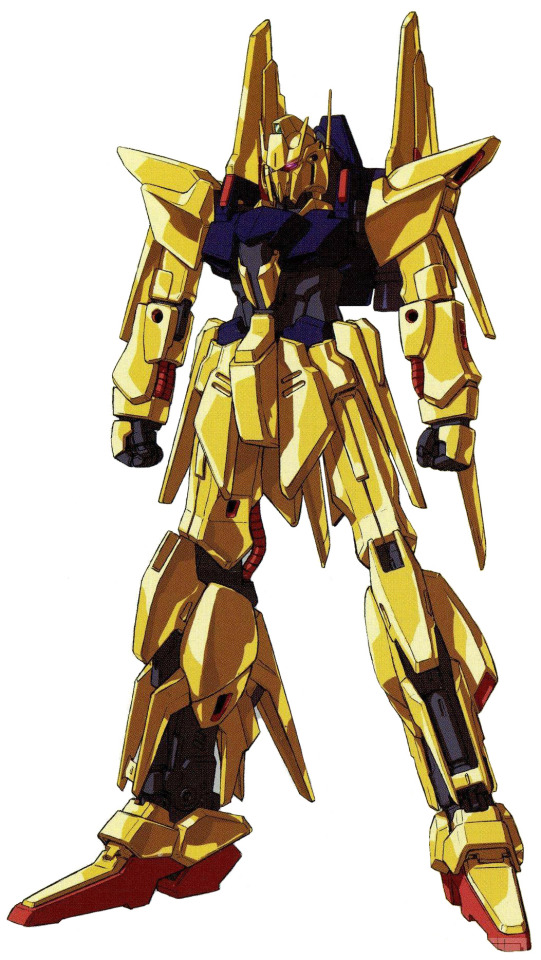
I’m specifically going to be talking about the design and it’s variants. What I’m not going to be talking about is the Hyaku Shiki, and it’s variants, since those are a whole separate topic I want to cover at some point, though I will be comparing to the base Hyaku Shiki at times.
So, the Delta Gundam is the original prototype design to the Hyaku Shiki (or at least close enough there’s little difference). Had it been built it would have been one of the first transformable mobile suits of the Gryps war. However, the frame suffered from structural issues, so it was instead completed as the Hyaku Shiki, which would be piloted by Quattro Bajeena (Aka Char Aznable) during the Gryps War. It’s one of the few mobile suits that we know for a fact was never built (at least at the moment) and is arguably the closest Char ever got to piloting a Gundam-type mobile suit (discounting the Mk-II heist at the start of the Gryps war).
I think it’s honestly gorgeous, for being the in-universe first crack at third-generation mobile suits. A lot of the design feels very Zeta-esque to me, but it’s got more heft to it comparatively (probably because of the wing binders). I absolutely love the head, it just looks so sinister and it contains the same IDE (Image Directive Encode) system that made the original Hyaku Shiki such a good sniper. The rifle is also very nice, it’s got a very gryps-era design, but it somehow feels fuller and deadlier. The Delta Gundam stores it’s beam sabers in its shield, where they also function as beam guns. Honestly, I forget about this feature a lot simply because that’s something that was more common during the Neo Zeon War, and it makes the Delta Gundam feel overarmed to me. It’s just such a lovely blend of the Zeta, Hyaku Shiki and Mk-II, which were fairly light on integrated weaponry. The design also feels considerably more contemporary - it’s officially part of the Gundam Unicorn MSV, despite it being in-universe from the Gryps War, so it’s possible that this is an in-universe “refined” concept. The comparatively simple design also makes its unique features (the wings, the head, the gold) pop more.
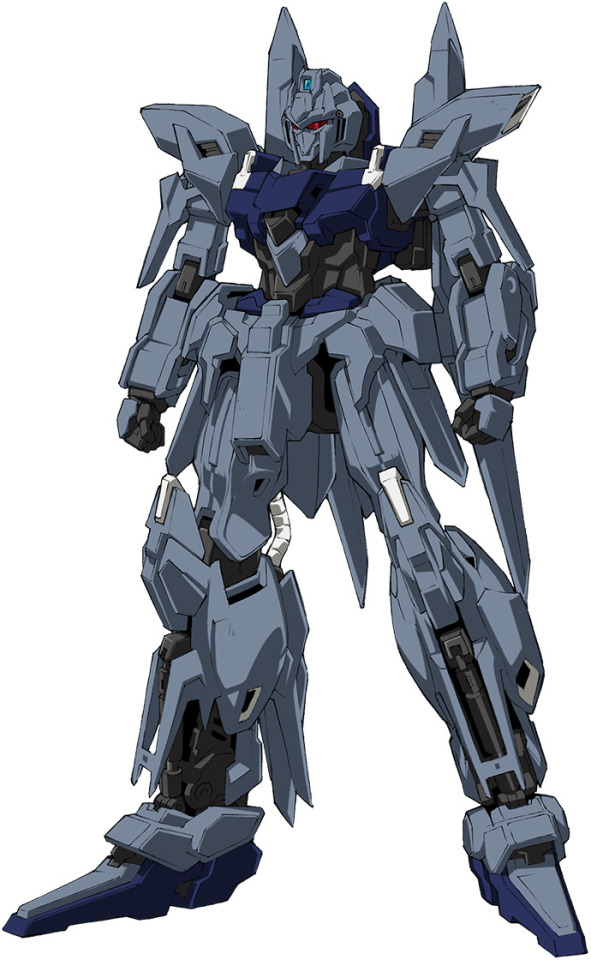
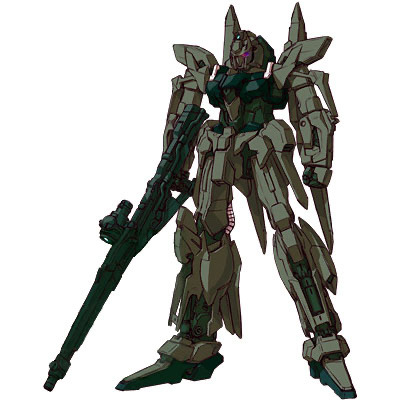
The Delta Plus.
The Delta Plus is a limited production suit built by Anaheim Electronics based no the original Delta Gundam. It’s essentially a mashup of the Delta Gundam and the Zeta Plus series. Compared to its predecessor, it trades the golden Anti-Beam coating for heavier firepower and a transformation system that actually works. It’s also equipped with a simple bio-sensor for use by newtypes.
For Armaments, it retains the Vulcans, Beam Sabers (and thus beam guns) and (now-optional) beam rifle of its predecessor, while it gains a 2-barrel grenade launcher and besm cannon, both built into the shield. Additionally, it was equipped with a Long Mega Buster, first used by the Full Armour Hyaku Shiki Kai, as standard armament. Why is this important? Because the Long Mega Buster is essentially a handheld version of the Original Hyaku Shiki’s Mega Bazooka Launcher, giving the Delta Plus significant firepower compared to its predecessors. It would be piloted by Riddhe Marcenas during the LA+ Incident (or Third Neo Zeon War).
So what do I think about it? Ehhh….. I don’t really dislike the design, but it’s just a little drab. It suffers because I like both the Delta Gundam and the Hyaku Shiki, so despite the armament increase, the Delta Plus just feels like a downgrade. I like the Zeta Plus series, which the Delta Plus takes obvious influence from, but the problem is that I like them because they have a soft, rounded, aerodynamic look compared to the sleek, angular nature of the original Zeta Gundam. The Delta Plus is just more lines and angles, it feels too different from them from a design perspective. There’s also it’s usage in the story, which I want to talk about.
Okay, I understand why Riddhe’s in Unicorn. I understand who he is and what he represents so I don’t really have to like him, per se. I view him getting the Delta Plus as shorthand for “he’s an important character now, pay attention” and because people like the Hyaku Shiki, he gets a suit based on that. Problem is, other than being able to independently enter the atmosphere (*cough* Ballutes *cough*), I don’t really see what the Delta Plus adds that wouldn’t be provided by a ReZel. I’ll admit this is partially because I’ve been coming around to liking the ReZel a lot more lately, but I just don’t think the Delta Plus adds much. The Delta Plus is eventually absolutely mauled by the Banshee, and while it’s a pretty good “death” scene, it’s destroyed functionally so Riddhe can get a new suit. I mentioned it contains a simple bio-sensor before, but despite Riddhe’s newtype potential, I don’t think it ever comes up in-series.

The Gundam Delta Kai
A thoroughly upgraded Delta Plus, designed as a next-gen demonstration machine. It’s essentially chock-full of fancy weaponry and experimental systems.
Honestly, it’s equipped with a lot of optional weaponry that I wasn’t aware of, so I’m just going to be focusing on its “basic” loadout here (IE What’s on the model kit). It’s equipped with Vulcans, Beam Sabers (which again double as beam guns), a Long Mega Buster (as with the Delta Plus), a High Mega Cannon, built into the shield and based on the ZZ (though with the output ratcheted back quite significantly), and finally, some proto fin funnels swiped from the Nu Gundam’s development. It’s also equipped with the n_i_t_r_o system, which temporarily enhances a normal pilot into a cyber Newtype and causes the mobile suit to emit blue flames. It also makes the pilot unusually aggressive and unstable. So, basically an EXAM system in a hat and moustache. Honestly, I tend to forget about it.
So, the Gundam Delta Kai is gorgeous. It’s a fourth-gen mobile suit with a bunch of armaments, I like how the blue and yellow break up the predominantly while colour scheme and it’s got an actual Gundam-style head. Though I wasn’t able to find a good picture of the shield it integrates far better than you’d expect from its design. The funnels are oversized and delightful, since they change its whole silhouette and give the impression of an increased armament (if the high mega cannon didn’t already). I also want to call out that I especially love the thruster design on this thing. 10/10, no further notes.
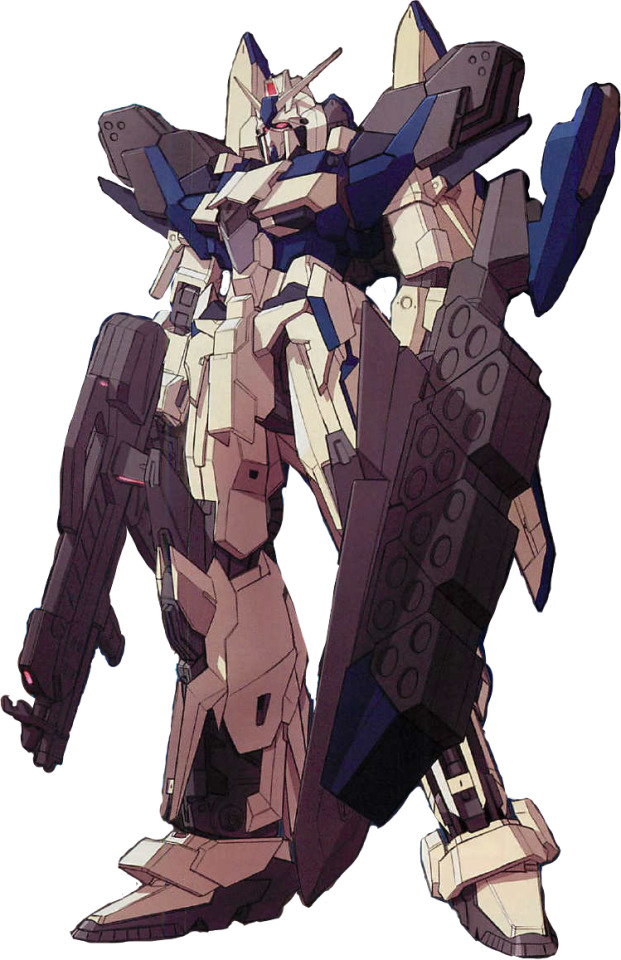
The Gundam Delta Kai would eventually be upgraded into the Land Combat Gundam Delta Kai. I’m gonna be honest, I don’t really have much of an opinion of this one. Or really anything to say about it.
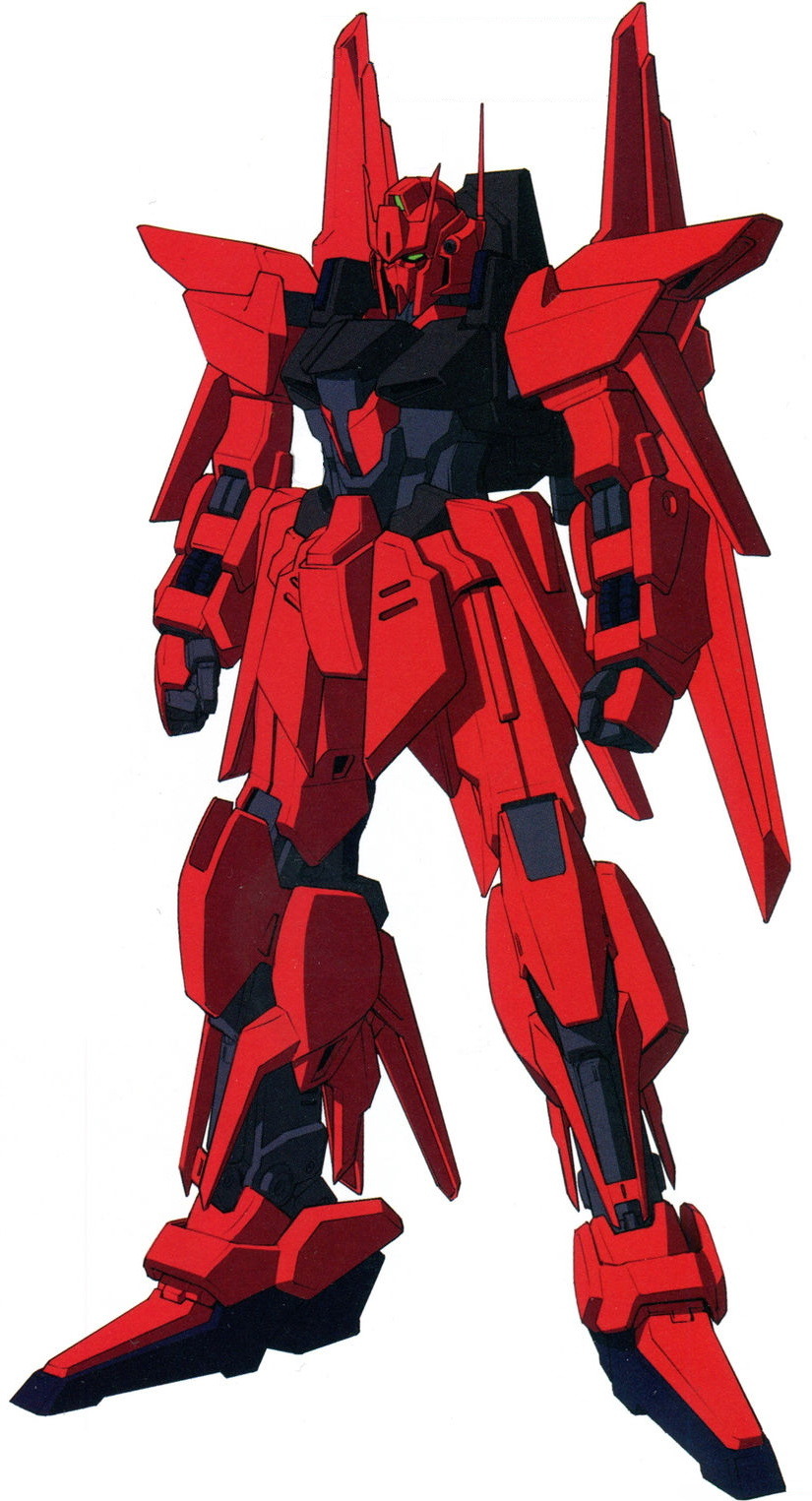
The Delta Gundam II.
An identical, red copy of the original Delta Gundam, its plans were pitched to Karaba in November of UC 0087, in the middle of the Gryps War, but it was rejected due to the fact it would take too much time to be built. Out-of-universe, it’s an excuse to sell the Delta Gundam in Char’s colours, but I find I rather like it. The flat colours allows the design to take on greater definition in some areas (such as the head) and to pleasingly evokes the Zero-Shiki (and thus the Rick Dias) to me.
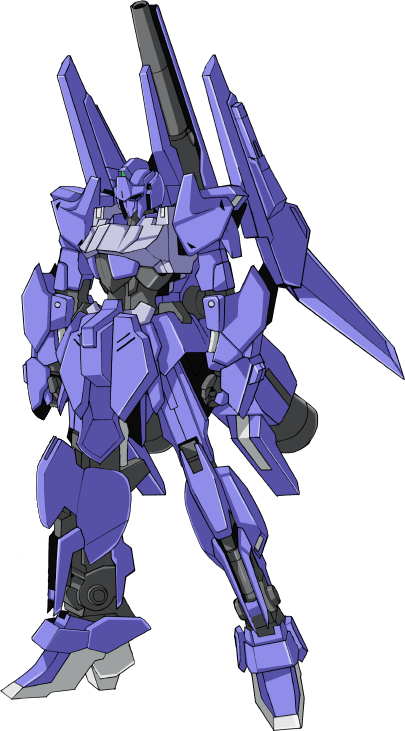
Finally, we come to the Mega-Shiki. A Gunpla ordered by Team G-Master for the Gunpla Battle Championship, built by Minato Sakai. It’s essentially a purple mash-up of the Delta Gundam and Hyaku-Shiki, with an integrated Mega-Rider from ZZ as its backpack.
Armaments are: Vulcan Guns in the head, a beam rifle identical to that of the Delta Gundam, two beam sabers styled after samurai swords (functioning similarly to Beam Cutlasses from Gundam Crossbone) and the Mega Beam Cannon mounted on the Mega Rider backpack (honestly it’s called a beam cannon, high mega beam cannon, mega launcher, so I just made my best guess. It’s essentially the Hyaku Shiki’s Mega Bazooka Launcher but better integrated). It retains the anti-beam coating of its predecessors, but it’s coloured purple.
The Mega Shiki is another of those rare models I would get to mod and paint. The purple colour scheme doesn’t do it for me, but it could be repainted in a variety of Gryps-war appropriate colour schemes that I’d find quite enjoyable. I like how the Mega Rider’s integrated, but I’d honestly much rather knock it off, replace the backpack with a standard Hyaku-Shiki one, and use it as the Hyaku-Shiki does - a sort-of sub-flight system meets really big gun. I understand the idea behind the beam katana’s but I just don’t really think they add anything to the design. In a nutshell, it’s a nice concept, but the execution feels like it’s going in too many directions at once. It is my understanding that the HG model contains several spare Delta Gundam Parts however, such as the head (but not the backpack), so it does have options as a model.
#I would have made this a Delta Gundam kit review but I couldn’t find any nice pictures#Autocorrect wanted to name them Team G-Nasty#Delta Gundam#Delta Plus#Delta Gundam Kai#Delta Gundam II#Mega-Shiki#UC-MSV#Gryps War#Gundam#Ramblings#Build Fighters
20 notes
·
View notes
Text
DC Comics highschool AU where Bruce 18 and Harvey 18 are the golden twins (lovers) of the football team, but after an injury, Harvey is replaced with that nerd from smallville who's in the school's newspaper, and he's able to make Bruce cheer too !
Grrr
So Harvey's integrating the cheerleaders (and debate) team to stay close of the field and his mentor is the girl rumoured to be the great grandgirl of the last Chinese Emperor Talia Al-Ghul.
In this AU, there is an unofficial club of heavily mentally scarred gothamite kids, you know who i'm talking about, and they have been adopted by the Golden Twins (lovers), so better not mess with them.
Everybody knows Dick 17 , he has to settle down in Gotham when his parents died and social services were looking for a solution, Alfred Pennyworth took him in, he was there with Bruce that night. Captain of the gymnastic team, no enemy guy, the only one able to shine brighter than Harvey. Someone tried to mess with his girlfriend once, Kori Anders, apparently he also learnt muay thai on the road.
Jason Todd 16 , Stephanie Brown 15 , Duke Thomas 14, Harper 16 and Cullen Row 14 can't and won't deny coming from Park Row, sorry, crime alley, Duke is actually from Bristol, but you know, nuances are too complicated. They met each other in foster system and Dick too.
One day, when the orphanage was running very low on money, Jason appeared with multiple bags of food. The others thought he was joking when he said he stole the 4 wheels of the mayor's Bentley, when he, Jacob Kane, came with the police they weren't joking so much.
Long story short, they are Kane's wards now, it's was a package deal.
Jay and Duke are making the glorious hours of writing club, Jason would like theater and Duke chemical but Jacob made them pick a sport, Jason was kind of forced to go to the football defensive team, (Jake didn't digest the L against Metropolis in 86) and Duke for the running team. As fast as light.
Steph is Lois Lane's right hand for the school's newspaper, she's running their social medias with great sucess and is the head of gossip departement. Clark is the left hand for the investigation departement. She won against Jason, Harvey, Clark and others *wink wink* the biggest eater contest. She's now a subject for the quantum physics club.
Harper leads the electronics club, the school still remembers when her dog sized spider drone was unleashed. She's also in the kickboxing club.
Cullen is vibing in the theater and art club.
Kate Kane 18 can't stand all the dumbasses above but if she has a dream where you are glaring at them she will break your knees. Her father wanted her to do ballet, she's doing music and kickboxing. Bullying is her love langage.
Tim Drake 15 is a little genius coming in HS at 12, a unique feat until a certain someone from middle east came to school... He's driving Edward Nygma insane by solving all his riddles, photography and and electronic club. His parents are rich but always absent. 7 years ago, Alfred invited him for thanksgiving, never really left since.
Damian Al-Ghul 13 and Cassandra Wu-San 16 are cousins, they are not related but their family have known each other forever and Cass was there the day the demon spawned. Damian is Dusan's Al-Ghul son, who's 30 years older than his little sister Talia, the two are really too much well trained in martial field to be normal. Damian's is leading the escrima club.
Cass, despite being mute, is leading kickboxing club, noboby ever won a round against her. In the entire country. Except for her big sister Sandra Wu-San, also known in professional wrestling as Lady Shiva, who could give her a draw. Also she can't use technology to save her life.
The Wu-San are the adopted daughters of Dinah Drake (second cousin of Tim) and Ted Grant, a former world heavyweight boxing champion and a professional wrestler known as Wildcat. Together they have a bio daughter, Dinah Jr Laurel Drake-Grant.
A girl, Selina Kyle 18 claims she's not related to them but still has a permanent room in their house if she wants to come. Teddy met Jacob Kane in the army and were deployed in middle east together, he found his girls in some destroyed village in the Middle East and resigned right after.
Talia and Damian are from one of the oldest Asian family, and very old money. Some argues that was their family who created the first philosopher's stone. Their grandpa being the only person on Earth from the XIX century still alive is not helping. Ras wife's family helped the Americans in the Middle East that how he met Ted and Jacob.
Talia 18 is in the cheerleading club because of her HUUUUUUUGE crush on Bruce Wayne, best grades ever everywhere. Wants to become a vet.
Nyssa 17 Al-Ghul is in the kickboxing club and write her secret stuff just for her.
Barbara Gordon 17 is the daughter of the commissionner, someone shot her, she's paralysed. She's the captain of wheelchair basketball and in the electronics. She's a godess at armwrestling. For real she's an hydraulic press. She's really close of Dick Grayson and maybe she has adopted Steph, Cass, Harper as hers. Her own pose in school is with Dinah Laurel and Helena Bertinelli.
She's very competitive and will take very badly if Tim is just behind her again at the Olympics of hacking this year.
Diana 18 (who is at least as tall as Clark, i'm right on this) is leading the wrestling team and history club, she's a exchange student from Greece from a monastry where men are forbidden as a diplomatic move with her sisters. (in reality the opposite exists, for real). Her accent makes every boys and girls fall for her. She has a very strong sens of justice. One day she saw Bruce and Clark, not even talking together and..."Your mine now ! We're having tacos tonight !" They knew they couldn't negotiate.
Ollie Queen 18, everybody knows he will go to a board school one of the four (three) true childhood friends of Bruce Wayne. Captain of the archery team. Came with his own crew, all in the team. Desperatly in love with Dinah Jr.
Zatanna Zatara 18, her father was a close friend of Thomas Wayne, she's on a very good way to become a magician herself. One of the four (three) true childhood friends of Bruce Wayne. Leads theater club.
Hal Jordan 18, wants to become a jet fighter, obsessed with construction games. Mathematic club and running team.
Kendra Saunders 18, also known as Hawkgirl, because the week-end she's doing BASE Jump.
John Jones 18 and his half-sister Megan Morse 17, they are refugees from oversea after a coup. They love the special effects in movies and theaters so they are is this club. They came with
Kori Anders 17, princess in exile of Tamara, she's a really sweet girl so the school asked their sweetest student to guide her through her new life : Dick Grayson. Nobody knows how she mastered english in so little time. She had troubles with the differencies beetween the two countries. Everyone's favourite. Hurting, even a little Kori is declaring war to the whole school. She's also taller than anybody and very muscular. She kinda adopted Jason ?
Rachel Roth 14, is the daughter of the King of Azaroth, nobody really knows where it is. She's in the meditation and spiritual club. The only one allowed to hug, kiss, and touch her is Kori. The constant barking with Damian Al-Ghul can't only be hatred.
Donna Troy 17, Cassie Sandmarks 15 and Artemis Grace 16, they came with Diana. They all had a "Oh my god, he's so pathetic, I love him." With a Gotham Boy. They are all very tall and strong and in the weightlifting club.
Clark 18 and Jon 14 come from Smallville and are, 1) the sweetest guys ever, 2) fucking STRONG, there is a video on the differents groupchats of them, lifting the school gargoyle after a storm. Maybe farm strenght isn't the only explanation.
Kon 15 and Bizz 14 are from metropolis, Ma Kent's sister married Papa Luthor and they had Lex and then one rebelious and one albino with a speach impeachement, who is also the size of a polar bear. But, beware, Bizz is Jason Todd and Artemis love child. They haven't really figured yet what they want to do. Bizz is in special class with Cassandra Wu-San so you can regulary see her on his back giggling.
Linda 17 and Karen 18 kent, cousins of Clark by Pa Kent came back in town a few years ago after they lived their whole life in California. Linda is in the well-being club and liked by everyone. Karen is more on the amazonians side of the force and can't help herself but have homoerotic sparring with any strong woman on sight.
Dinah Jr Laurel Drake-Grant 18 embrassed her mom legacy and already took the mantle of Black Canary and can already put stages on fire. Her perfect figure must not makes you forget that she can beat your ass in seconds because she's in the kickboxing club too. Probably why Ollie is so in love. If you ask her if she's single, she would either tell you to fuck off if dhe doesn't like you or tell you she's already married with further explanation. (Could be either the stage, or Barbs and Helena).
Roy Harper 17 is in the archery team and music club with Dinah, nobody can sing the country and blues like him. He kinda adopted Jay with Kori too. Him and Jay made a pact to quit alcohol and drugs after they had a bad trip together on a joint in the toilet at a party together.
Lian Harper 14 is his little sister and will stay single until she's 30, at least. Well, everyone on the Arrow Team would like that. She loves hanging out with Dick and the others. Archery team too.
(I don't actually quite know a thing on the rest of the team, but they are there and well.)
The Allens all have their buddies too and are putting the race tracks on fire. Their father Jay Garrick holds multiple records of speed and gold medals. But not for long to his hapinness.
The Curry family comes from the islands in pacific ocean and are setting new records every years in swimming competition. They are all in bio courses to study marine life.
Harley Quinn 18 went in school with Bruce after his parent's murder, saw him sad, and never left him. One of the four (three) true childhood friend. She won't follow any rules but she's not a bad person. Wants to help everyone with their mental health, got a pretty big tik tok account and instagram on this topic. Her ex boyfriend, Jack, made her do bad things. But her (girl)friends Pamela, Selina and Bruce and a few others (all the people above) quickly talked to him. (Alfred signed a 100 000 dollars check for surgery)
Pamela Isley 18 leads the botanic club, she doesn't like people, like at all, would talk to grass but not you, she only started to like her figure when Harley couldn't stop ranting about her "water melon boobies" and "starship butt" in PE's locker room . Anybody else would be dead, but...It was Harley ? And Selina was laughing her ass off.
Selina Kyle 18, aka Catgirl because she's always wearing stuff with cat, her bagpack, cat ears, cat make up. She has a super model walk and won't accept shit from anyone. She wants to be a vet with Talia.
Jack Napier : still in the coma. AKA Joker, a nickname gained in jail for minors.
Thomas Eliott 18, the minus one true childhood friends of Bruce Wayne, wants him dead. Jealous that he had his inheritance before him.
(I spent 4 hours on this. Why ? BECAUSE I'M BATFAN)
#batman#batfamily#arrowfam#barbara gordon#bruce wayne#batgirl#damian wayne#dick grayson#jason todd#joker#black canary#high school au#superman#superfamily#stephanie brown#harper row#duke thomas#cassandra cain#lady shiva#kate kane#selina kyle#talia al ghul#brutalia#bruharvey#superbat#harlivy#gotham city sirens#dinahbabs#wonder woman#justice league
37 notes
·
View notes
Text
How UV Light Stabilizers Are Saving Products (and Profits) from Sun Damage

Introduction
The global UV Light Stabilizers Market is witnessing robust growth, driven by the increasing demand for UV-resistant materials across diverse industries. With a projected market value of USD 2.67 billion by 2025 and a compound annual growth rate (CAGR) of 6.3%, this industry is poised for substantial expansion. By 2033, forecasts indicate that the UV light stabilizers marketwill surpass USD 4.1 billion. As industries increasingly prioritize durability and product longevity, the demand for UV stabilizers in plastics, coatings, adhesives, and agricultural films continues to surge.
Request Sample Report PDF (including TOC, Graphs & Tables): https://www.statsandresearch.com/request-sample/40573-uv-light-stabilizers-market
UV Light Stabilizers Market Dynamics
Key Growth Drivers
Rising Demand for UV-Resistant Materials
The automotive, construction, packaging, and agricultural sectors are major consumers of UV stabilizers due to their role in enhancing product longevity and aesthetic durability.
Increased Awareness of Material Degradation
Continuous exposure to UV radiation can lead to the deterioration of polymers, coatings, and other materials, necessitating the incorporation of stabilizers to ensure longer-lasting products.
Expanding Application in Emerging Industries
With advancements in 3D printing materials, bio-based plastics, and smart coatings, UV stabilizers are being integrated into innovative applications that enhance material performance.
Get up to 30%-40% Discount: https://www.statsandresearch.com/check-discount/40573-uv-light-stabilizers-market
Challenges Facing the UV Light Stabilizers Market
High Production Costs
The production of high-performance UV stabilizers involves significant investment in research and development, which can lead to increased costs for manufacturers and end-users.
Environmental and Regulatory Concerns
Stringent regulations on chemical additives pose challenges for market expansion. Manufacturers must develop eco-friendly alternatives that comply with global environmental policies.
Compatibility Issues with Various Polymers
Ensuring that UV stabilizers are compatible with different polymer materials remains a key technical challenge for industry players.
Opportunities for UV Light Stabilizers Market Growth
Innovation in Sustainable UV Stabilizers
The shift towards non-toxic, eco-friendly stabilizers presents a lucrative opportunity for businesses looking to align with green chemistry principles.
Nanotechnology Integration
The incorporation of nanotechnology in UV stabilizers enhances their effectiveness, providing superior protection against degradation and extending product lifespan.
Agricultural Advancements
UV stabilizers play a crucial role in enhancing the durability of greenhouse films and protective covers, contributing to increased crop yield and efficiency.
UV Light Stabilizers Market Segmental Analysis
By Type
Hindered Amine Light Stabilizers (HALS): Widely used for long-term UV protection in coatings and plastics.
UV Absorbers: Effective in absorbing harmful UV radiation to protect materials from degradation.
Quenchers: Help in dissipating excess energy to prevent polymer breakdown.
Others: Includes novel stabilizers with specialized applications.
By Application
Plastics: A significant segment due to extensive use in packaging, construction, and automotive parts.
Coatings: Essential for protecting surfaces from UV-induced fading and deterioration.
Adhesives & Sealants: Used to enhance durability in bonding applications.
Others: Includes niche applications in electronics, textiles, and aerospace.
By End-Use Industry
Automobile: UV stabilizers contribute to the longevity of automotive parts and coatings.
Construction & Building Materials: Essential for ensuring the durability of exterior coatings and structural components.
Packaging: Plays a crucial role in preserving product integrity, particularly in food and pharmaceutical packaging.
Others: Includes emerging industries integrating UV stabilizers for enhanced product performance.
By Region
North America: A leading UV light stabilizers marketdriven by high demand in automotive and construction sectors.
Europe: Stringent regulations promoting the adoption of sustainable stabilizers.
Asia-Pacific: Fastest-growing region due to rapid industrialization and increasing investments in polymer industries.
South America & Middle East/Africa: Emerging markets with potential for expansion in construction and agriculture.
Future Outlook and Emerging Trends
Transition to Eco-Friendly Stabilizers
As sustainability gains traction, manufacturers are investing in bio-based and non-toxic UV stabilizers to meet regulatory requirements and consumer demand for environmentally friendly products.
Advancements in Smart Coatings
Smart coatings infused with UV stabilizers are being developed to enhance self-healing properties and improve material resilience under extreme environmental conditions.
Growth in the 3D Printing Sector
With the increasing adoption of 3D printing in manufacturing, the need for UV-resistant materials has surged, providing new growth opportunities for the market.
Purchase Exclusive Report: https://www.statsandresearch.com/enquire-before/40573-uv-light-stabilizers-market
Conclusion
The global UV Light Stabilizers Market is set to experience significant growth, driven by increasing awareness of material degradation and the demand for durable products across various industries. Despite challenges such as high production costs and regulatory hurdles, innovations in nanotechnology and sustainable stabilizers offer promising prospects. As industries continue to prioritize longevity and environmental responsibility, the market for UV stabilizers will remain a critical component of modern material science.
Our Services:
On-Demand Reports: https://www.statsandresearch.com/on-demand-reports
Subscription Plans: https://www.statsandresearch.com/subscription-plans
Consulting Services: https://www.statsandresearch.com/consulting-services
ESG Solutions: https://www.statsandresearch.com/esg-solutions
Contact Us:
Stats and Research
Email: [email protected]
Phone: +91 8530698844
Website: https://www.statsandresearch.com
#UV Light Stabilizers Market#UV Stabilizers#Light Stabilizers#Market Trends#Chemical Industry#Plastic Additives#Polymer Stabilizers#UV Protection#Coatings Industry#Automotive Coatings#Industrial Chemicals#Market Growth#Future Trends#Sustainability#Weather Resistance#Photostabilizers#Construction Materials#Automotive Industry#Polymer Additives#Global Market Analysis
1 note
·
View note
Text
FPGA Market - Exploring the Growth Dynamics

The FPGA market is witnessing rapid growth finding a foothold within the ranks of many up-to-date technologies. It is called versatile components, programmed and reprogrammed to perform special tasks, staying at the fore to drive innovation across industries such as telecommunications, automotive, aerospace, and consumer electronics. Traditional fixed-function chips cannot be changed to an application, whereas in the case of FPGAs, this can be done. This brings fast prototyping and iteration capability—extremely important in high-flux technology fields such as telecommunications and data centers. As such, FPGAs are designed for the execution of complex algorithms and high-speed data processing, thus making them well-positioned to handle the demands that come from next-generation networks and cloud computing infrastructures.
In the aerospace and defense industries, FPGAs have critically contributed to enhancing performance in systems and enhancing their reliability. It is their flexibility that enables the realization of complex signal processing, encryption, and communication systems necessary for defense-related applications. FPGAs provide the required speed and flexibility to meet the most stringent specifications of projects in aerospace and defense, such as satellite communications, radar systems, and electronic warfare. The ever-improving FPGA technology in terms of higher processing power and lower power consumption is fueling demand in these critical areas.
Consumer electronics is another upcoming application area for FPGAs. From smartphones to smart devices, and finally the IoT, the demand for low-power and high-performance computing is on the rise. In this regard, FPGAs give the ability to integrate a wide array of varied functions onto a single chip and help in cutting down the number of components required, thereby saving space and power. This has been quite useful to consumer electronics manufacturers who wish to have state-of-the-art products that boast advanced features and have high efficiency. As IoT devices proliferate, the role of FPGAs in this area will continue to foster innovation.
Growing competition and investments are noticed within the FPGA market, where key players develop more advanced and efficient products. The performance of FPGAs is increased by investing in R&D; the number of features grows, and their cost goes down. This competitive environment is forcing innovation and a wider choice availability for end-users is contributing to the growth of the whole market.
Author Bio -
Akshay Thakur
Senior Market Research Expert at The Insight Partners
2 notes
·
View notes
Text
Foamed Polypropylene Films Market 2025 Assessment and Key Insights Analyzed Till 2035
The foamed polypropylene films market is set to grow from USD 10,018.9 million in 2025 to USD 17,606.6 million by 2035, registering a compound annual growth rate (CAGR) of 5.8%. This robust growth is indicative of widespread adoption across various end-user industries.
Multiple factors contribute to this upward trend: increasing global demand for packaged foods, the evolution of automotive components, and the push for lightweighting in industrial applications. With governments around the world supporting circular economy initiatives and waste reduction, recyclable foamed PP films will only become more central to industrial supply chains.
Discover Growth Opportunities in the Market – Get Your Sample Report Now https://www.futuremarketinsights.com/reports/sample/rep-gb-11370
Foamed polypropylene films are lightweight, microcellular plastic films characterized by their exceptional thermal insulation, mechanical strength, water resistance, and recyclability. They are created through a foaming process that introduces gas into the polymer matrix, reducing material density while maintaining structural integrity. This results in a product that is not only economical and environmentally friendly but also extremely versatile.
These unique properties make foamed PP films a go-to material in food packaging, automotive insulation, protective packaging, stationery, labeling, and industrial uses. They offer excellent resistance to moisture, heat, and impact, making them ideal for safeguarding sensitive or perishable products.
Key Takeaways From the Foamed Polypropylene Films Market
The USA is projected to lead the foamed polypropylene films market with a strong CAGR of 6.0% from 2025 to 2035.
The European Union follows closely with a regional CAGR of 5.9%, highlighting robust demand across multiple member states.
Japan and South Korea are both forecasted to grow at a healthy CAGR of 5.8%, indicating strong market dynamics in East Asia.
The UK is also expected to show steady growth, with a CAGR of 5.7%, reflecting continued investment and demand in packaging and automotive sectors.
Unique Mechanical Properties Driving Industrial Preference
One of the key differentiators of foamed polypropylene films is their durability and mechanical strength despite their low weight. These films provide excellent heat insulation, water resistance, and chemical inertness, making them a preferred material in industries where performance and protection are critical.
In industrial applications, such as electronic component packaging and automotive interiors, foamed PP films provide a reliable barrier against environmental stress. Their impact resistance and ability to maintain structural integrity even under fluctuating temperatures ensure product safety during storage and transit.
Emerging Trends Shaping the Foamed Polypropylene Films Market
Sustainable and Biodegradable Innovations: While foamed PP films are recyclable, there is ongoing research focused on enhancing their environmental friendliness by integrating biodegradable additives or developing bio-based polypropylene. This trend is expected to gain momentum, further boosting market adoption.
Technological Advancements in Foam Processing: Improvements in foaming techniques are enabling manufacturers to produce films with better uniformity, finer cell structures, and enhanced mechanical properties. These innovations allow broader application ranges and improved performance, thus attracting more end-users.
Customization and Functionalization: Manufacturers are increasingly offering customized foamed PP films tailored to specific industry needs, including enhanced barrier properties, flame retardancy, or anti-static features. Such specialized offerings create competitive advantages and open niche market opportunities.
Recyclability and Environmental Appeal
The recyclability of foamed polypropylene films sets them apart in a market increasingly driven by environmental considerations. Unlike multi-material films that are difficult to separate and recycle, PP films can be reprocessed with relatively low environmental impact. This makes them attractive to companies that have sustainability mandates or participate in extended producer responsibility (EPR) programs.
Competitive Landscape
The foamed polypropylene films market is characterized by a mix of global chemical companies and specialized polymer manufacturers. Leading players are focusing on expanding production capacities, engaging in strategic collaborations, and investing in research and development to innovate new product grades that meet evolving customer demands.
Key Company Offerings and Activities
Toray Industries, Inc. – Develops high-performance foamed PP films for packaging, industrial insulation, and electronic applications.
3M Company – Produces lightweight and durable polypropylene films with enhanced thermal and impact resistance for industrial applications.
ExxonMobil Chemical Manufactures high-barrier foamed PP films for food packaging, automotive interiors, and protective films.
SABIC – Focuses on recyclable and high-strength PP foamed films, catering to sustainable packaging and construction industries.
Mitsui Chemicals, Inc. – Offers customized polypropylene film solutions with superior moisture and heat resistance for diverse applications.
Foamed Polypropylene Films Market Segmentation
By Thickness:
Up to 80 microns
81-120 microns
Above 120 microns
By Application:
Flocking
Decorative Products
Labels
Tapes
Packaging
By End User:
Food & Beverages Industry
Textile Industry
Decor & Furniture Industry
Packaging Industry
Cable Industry
Others
By Region:
North America
Latin America
Western Europe
Eastern Europe
East Asia
South Asia Pacific
Middle East and Africa
0 notes
Text
Polyethylene Wax Market analysis highlighting major trends and forecasts globally

The Polyethylene Wax Market is growing steadily due to expanding applications across industries and ongoing advancements in product formulation and processing.
Introduction: Understanding Polyethylene Wax
Polyethylene wax (PE wax) is a low molecular weight polyethylene used across multiple sectors due to its excellent hardness, abrasion resistance, and compatibility with other materials. It plays a critical role in coatings, inks, adhesives, plastics, rubber, and packaging industries.
With increasing demand for performance-enhancing additives, the global PE wax market is witnessing strong growth. The shift toward cleaner, more efficient, and cost-effective solutions in manufacturing has brought PE wax to the forefront of materials innovation.
Key Global Market Trends
Several trends are shaping the global polyethylene wax market, including:
1. Surge in Demand from Packaging and Printing Industries: With sustainability goals in focus, industries are shifting toward materials that offer better recyclability and lower environmental impact. PE wax enhances surface smoothness, gloss, and abrasion resistance in printing inks and coatings, making it an integral component.
2. Growth of Masterbatches and Plastic Processing: PE wax acts as a dispersing agent in masterbatches, aiding uniform color distribution and processing efficiency. This segment’s growth is being driven by rising plastic demand in automotive, consumer goods, and construction.
3. Focus on High-Performance Modifiers: Industries are demanding customized PE waxes with specific melting points, molecular weights, and hardness levels. Modified and oxidized PE waxes have gained traction due to their improved compatibility with polar resins and enhanced performance.
4. Expansion of Hot-Melt Adhesives and Lubricants: PE wax contributes to viscosity control and flow properties in adhesives and lubricants. These segments are growing, especially in electronics, woodworking, and packaging industries where strong bonding and temperature resistance are crucial.
Regional Forecast and Performance Overview
The polyethylene wax market is expanding globally, with varying dynamics in different regions:
North America: This region remains a dominant market, fueled by mature industrial bases and strong demand from plastics and coatings manufacturers. The United States holds a major share, with consistent investments in product innovation and environmentally friendly alternatives.
Europe: Driven by eco-friendly regulations and technological advancements, Europe is experiencing moderate growth. The demand for high-quality printing inks, automotive coatings, and packaging films continues to boost PE wax applications.
Asia-Pacific: This region is projected to witness the highest growth rate, led by countries like China, India, South Korea, and Japan. Rapid industrialization, urbanization, and the expansion of manufacturing infrastructure are increasing the consumption of PE wax, particularly in packaging and plastics.
Latin America, Middle East & Africa: While still emerging markets, these regions show significant potential, especially as infrastructure develops and consumer demand for packaged goods rises. Brazil and UAE are emerging as strategic markets for wax-based coatings and additives.
Technological Advancements and Product Innovation
Innovation plays a vital role in sustaining market growth. Companies are investing in R&D to develop:
Bio-based PE waxes for improved sustainability
Oxidized polyethylene waxes for enhanced emulsification
Fischer-Tropsch derived waxes offering ultra-high purity
Process improvements such as controlled polymerization and blending techniques allow better customization of PE wax grades, targeting specific end-user needs.
Market Forecast and Projections
According to industry estimates, the global polyethylene wax market is expected to grow at a steady compound annual growth rate (CAGR) through 2030. The growth is attributed to:
Increased usage in advanced plastic processing and masterbatches
Expanding application base in rubber and textiles
Higher adoption in industrial and decorative coatings
The market will likely surpass significant revenue benchmarks, particularly as Asia-Pacific's contribution increases and technological advancements create new product categories.
Challenges in the Market
Despite positive growth, the market faces some constraints:
Volatility in raw material prices, particularly ethylene, can affect production costs.
Environmental concerns over synthetic wax disposal and recyclability are prompting stricter regulations.
Competitive pricing pressure among manufacturers limits margin flexibility.
Addressing these challenges will require companies to focus on sustainability, cost optimization, and innovation.
Strategic Recommendations
To capitalize on the opportunities, industry players should consider:
Diversifying their product portfolios with bio-based and eco-friendly variants
Strengthening distribution networks in emerging economies
Collaborating with end-users to develop customized PE wax solutions
Investing in digital platforms for better customer outreach and brand visibility
Market leaders who stay agile and responsive to evolving demands will retain a competitive edge.
#polyethylenewaxmarket#waxindustrytrends#chemicalmarketanalysis#packagingadditives#plasticsprocessing#globalwaxdemand#industrialmaterials#marketforecast#pewaxapplications#waxmarketgrowth#coatingindustry#printinginks#adhesivesindustry#biofriendlymaterials#waxinnovation#asiapacificmarket#globalchemicalindustry#materialsmarketanalysis#pewaxsolutions#industrialwaxusage
0 notes
Text
Paper-based Biofuel Cell Market to Reach $580 Million by 2034: Key Growth Drivers
The global paper-based biofuel cell (PBFC) market, valued at approximately US$ 300 million in 2023, is poised for significant growth, expected to reach US$ 580 million by 2034. This expansion reflects a compound annual growth rate (CAGR) of 6.3% from 2024 to 2034, driven by increasing adoption of wearable electronic devices and rising prevalence of lifestyle diseases that demand innovative energy solutions for medical devices.
Understanding Paper-based Biofuel Cells
Paper-based biofuel cells convert biological energy from natural substrates into electricity using biological catalysts. There are two primary types of PBFCs:
The unique qualities of PBFCs — lightweight, biodegradable, and biocompatible — make them ideal for powering low-energy devices like wearables and implantable medical devices (IMDs).
Market Drivers: Wearable Electronics and Medical Devices
The surge in wearable electronics, such as fitness trackers and smartwatches, is a major growth engine for the PBFC market. These devices require compact, lightweight, and environmentally friendly power sources that can seamlessly integrate with the human body. PBFCs, with their biodegradability and ability to harvest energy from biofluids, present an attractive solution.
In addition, the increasing incidence of lifestyle diseases such as diabetes is accelerating the need for IMDs, which demand reliable, long-lasting, and biocompatible power sources. PBFCs can power these devices efficiently, improving patient outcomes while reducing environmental impact compared to conventional batteries.
Epicore Biosystems’ recent investment rounds highlight growing interest in wearable microfluidic solutions that leverage these technologies, especially in markets across Japan and Asia.
Technological Advancements and Challenges
Despite the promising outlook, PBFC technology faces notable challenges, primarily related to its lower power density compared to traditional fuel cells. This limits the range of practical applications for paper-based biofuel cells.
To address these issues, companies are collaborating with academia and government institutions to enhance efficiency and power output. Breakthroughs in enzymatic catalysts, hybrid battery systems combining MFCs with electrochemical generation, and novel bio-ethanol fueled systems are some key areas of research. For example, Nissan Motor Co., Ltd. is trialing a high-efficiency bio-ethanol system in Japan aimed at full-scale power generation by 2030.
Regional Market Insights
The Asia Pacific region dominates the PBFC market, driven by robust R&D initiatives and growing healthcare infrastructure. China’s development of a fast-charging hybrid battery system for wastewater treatment underscores the region’s innovation capacity.
North America also holds significant market share due to expanding healthcare expenditures and advancements in medical device technology. The U.S., in particular, is witnessing increased demand for IMDs to manage chronic diseases, bolstering PBFC adoption.
Competitive Landscape
Several key players are shaping the market dynamics by focusing on the medical sector and other emerging applications like IoT devices and environmental monitoring. Major companies include:
Notably, BeFC raised €16 million in 2023 to scale production of bio-inspired enzymatic fuel cells, targeting a million units per day by the end of 2024 and global expansion in 2025.
Future Outlook and Opportunities
The paper-based biofuel cell market’s growth is tightly linked to trends in wearable technology and healthcare. As demand for smart, eco-friendly, and biocompatible power sources grows, PBFCs are likely to become integral in powering next-generation devices.
In addition, new applications in environmental monitoring and IoT offer additional avenues for market expansion. The market will benefit from ongoing research to improve power density and scalability.
With environmental sustainability becoming a global priority, the biodegradable nature of PBFCs gives them an edge over conventional batteries, positioning the technology as a future cornerstone of clean, wearable, and implantable energy solutions.
0 notes
Text

Eco-friendly conductive ink promises to revolutionize the production of soft stretchable electronic circuits
Researchers at the Faculty of Science and Technology of Universidade de Coimbra (FCTUC) and Carnegie Mellon University have developed a water-based conductive ink tailored for producing flexible electronic circuits. The technique, developed with Carnegie Mellon Portugal Program's (CMU Portugal) support, sidesteps the necessity of employing conventional organic solvents, renowned for their detrimental environmental impact due to pollution and toxicity. The results have been published in the journal Advanced Science. By being water-based, this ink is more sustainable and ecological and significantly reduces the environmental impact of existing solutions. On-skin bio stickers to monitor patients' health or recyclable smart packages with integrated sensors for monitoring the safe storage of perishable foods are among the possible uses. Manuel Reis Carneiro, a doctoral student from the CMU Portugal, is part of the team led by Mahmoud Tavakoli, which already has extensive experience developing stretchable electronic circuits efficiently, quickly, and cheaply.
Read more.
#Materials Science#Science#Ink#Conductivity#Electronics#Circuits#Wearable technology#Environment#Carnegie Mellon University
23 notes
·
View notes
Text
Engineering Thermoplastic Market Share, Industry Size, Opportunity, Analysis, Forecast 2033
The global engineering thermoplastic market is valued at US$ 292.2 billion in 2023 and is projected to grow at a CAGR of 5.9%, reaching US$ 518.3 billion by 2033.
Renowned for its superior performance, engineering plastic has gained significant traction across various end-use sectors. The increasing adoption of engineered thermoplastics (ETPs) in fluid handling, agricultural equipment, and medical implants will drive market growth during the forecast period.
In the automotive sector, manufacturers are leveraging engineering thermoplastics to enhance fuel efficiency and meet stringent emission standards. These materials enable component integration, reducing vehicle weight and improving performance, thereby paving the way for the development of advanced thermoplastics tailored to future automotive demands.
Short Term (2023-2026): Growth is driven by engineering thermoplastics' application in automotive, construction, and packaging industries due to their superior characteristics.
Medium Term (2026-2029): Infrastructure investments and consumer preference for bio-based plastics are expected to boost demand, particularly in Europe and Asia.
Long Term (2029-2033): Innovations in PET separation from packaging waste and the rising adoption of electric vehicles will sustain demand for engineering thermoplastics in the long run.
The market's outlook underscores its vital role in shaping sustainable and efficient industrial solutions.
Get Free Sample Report to Grow Your Profit Margin – https://www.factmr.com/connectus/sample?flag=S&rep_id=5971
Drivers
Engineering thermoplastics are prized for their lightweight properties and high strength-to-weight ratio, making them ideal for applications across industries such as automotive, aerospace, electrical & electronics, and consumer goods. Their versatility and superior performance have driven increased demand in these and other sectors, including medical devices and industrial applications.
Unlike traditional plastics, engineering thermoplastics are recyclable and offer enhanced performance, positioning them as a sustainable alternative for companies seeking environmentally friendly solutions. This eco-conscious appeal is further supported by government regulations worldwide that encourage the adoption of such advanced materials in various industries.
Manufacturers are focusing on research and development to create innovative products that cater to the evolving requirements of end-use industries. These advancements are expanding the range of applications and strengthening market competitiveness.
Additionally, the rise of industrialization in emerging economies is bolstering the demand for engineering thermoplastics. Their durability and high-performance properties make them indispensable in industrial applications, particularly in regions undergoing rapid development.
With these factors in play, engineering thermoplastics are not only meeting current demands but also shaping the future of sustainable and efficient material solutions across the globe.
Key Market Trends:
The rise in electric vehicle (EV) production is significantly boosting the demand for engineering thermoplastics, which provide lightweight, durable, and heat-resistant solutions for critical components like battery casings, motor parts, and charging connectors.
The increasing adoption of 3D printing technology across industries is further accelerating this demand. Engineering thermoplastics are favored for their high performance and precision, making them ideal for 3D printing applications.
Additionally, there is a growing trend towards bio-based engineering thermoplastics, produced from renewable sources such as plant-based materials. These alternatives offer several environmental benefits, making them an attractive option compared to traditional petroleum-based plastics.
A heightened focus on recycling engineering thermoplastics is also emerging as a key trend. Their recyclability makes them a sustainable choice, aligning with global efforts to reduce waste and improve sustainability in manufacturing practices.
Advancements in technology are driving innovation in engineering thermoplastics, enabling the development of materials with superior performance properties tailored to the specific needs of various industries and applications.
Moreover, the growing adoption of smart manufacturing practices, including automation and robotics, is fueling demand for engineering thermoplastics, as these materials offer high-performance solutions for components in advanced manufacturing equipment.
Restraints
The higher cost of engineering thermoplastics compared to traditional plastics can act as a barrier, limiting their adoption in certain industries and applications where cost efficiency is a priority.
The production of engineering thermoplastics relies on specialized raw materials, which are often limited in availability. This scarcity can lead to supply chain disruptions and price volatility, impacting manufacturers and end-users alike.
Additionally, the processing of engineering thermoplastics poses challenges due to their high melting points and unique physical properties. These factors can result in increased production costs and longer processing times, making them less accessible for some applications.
Get Customization on this Report for Specific Research Solutions – https://www.factmr.com/connectus/sample?flag=RC&rep_id=5971
Regional Landscape:
Germany hosts a significant number of plastic production facilities and leads the region in plastics demand by converters. Additionally, the country is poised for rapid growth, driven by the expanding automobile manufacturing sector.
Meanwhile, India is experiencing rising demand for engineering plastics across industries such as building and construction, packaging, and automotive. Government-led initiatives and substantial investments in infrastructure development are further fueling the growth of the building and construction industry, boosting the demand for engineering plastics.
Competitive Landscape
Leading market players are ramping up production capacities to cater to the growing demand for engineering thermoplastics (ETPs) from industries such as packaging and automotive in emerging economies.
In September 2022, BASF inaugurated a production facility in China with a manufacturing capacity of 60,000 metric tons of engineering plastics, significantly boosting its production capabilities.
Additionally, key companies are heavily investing in research and development (R&D) to create innovative materials that are more sustainable and easier to recycle.
For instance, in 2022, SABIC introduced its LNP™ THERMOCOMP™ AM material, a cutting-edge thermoplastic composite designed for 3D printing applications. This high-performance material offers exceptional strength and stiffness, catering to diverse industries such as aerospace, automotive, and healthcare.
Key Companies Profiled
BASF SE
Eastman Chemical Company
3M
Dow
DuPont
Evonik Industries AG
Mitsubishi Chemical Holdings Corporation
Arkema S.A
Sumitomo Chemical Co., Ltd.
Read More: https://www.factmr.com/report/engineering-thermoplastic-market
Segmentation of Engineering Thermoplastic Industry Research
By Product :
Amorphous Engineering Thermoplastic
Styrene Copolymers (ABS/SAN)
Polycarbonate (PC)
Polymethyl methacrylate (PMMA)
Polyphenylene Oxide (PPO)
Others
Semi-Crystalline Engineering Thermoplastic
Thermoplastics Polyesters (PBT/PET)
Polyamide (PA)
Fluoropolymers (PTFE / Teflon)
Polyacetals (POM)
Polyether Ether Ketone (PEEK)
Polyphenylene Sulfide (PPS)
Others
By Shape :
Sheet
Rod
Tube
Film
Custom
Polypropylene
By End-Use Industry :
Packaging
Building and Construction
Automotive and Transportation
Electrical and Electronics
Household Appliances
Sports & Leisure
Agriculture
Medical
Others
By Region :
North America
Latin America
Europe
East Asia
South Asia & Oceania
MEA
𝐂𝐨𝐧𝐭𝐚𝐜𝐭:
US Sales Office 11140 Rockville Pike Suite 400 Rockville, MD 20852 United States Tel: +1 (628) 251-1583, +353-1-4434-232 Email: [email protected]
1 note
·
View note
Text
Why Laptop Chip-Level Repair is the Smart Choice for Cost-Effective Solutions
As laptops grow more compact and powerful, so does the complexity of their internal hardware. Most modern laptops are built on highly integrated circuit boards, where everything from the processor to the power controllers is embedded on a single motherboard. When something goes wrong at this level, basic troubleshooting won’t be enough. This is where chip-level laptop repair comes in—a specialized service that offers deep, precision-level fixes.
What is Laptop Chip-Level Repair?
Chip-level repair involves diagnosing and fixing faults directly on the laptop’s motherboard or logic board. These repairs target tiny components like resistors, capacitors, integrated circuits (ICs), and power chips. Instead of replacing the entire motherboard (which can be very expensive), chip-level repair focuses on correcting the specific fault at its source.
This service is especially helpful in cases of:
Laptop not powering on
No display or flickering screen
Charging port or battery not working
Overheating or auto shut-down issues
BIOS corruption or boot loop errors
Why Choose Chip-Level Repair Over Replacement?
Cost-Efficient: A new motherboard can cost up to 70% of the laptop's value. Chip-level repair saves money by replacing only the faulty component.
Eco-Friendly: Repairing instead of replacing reduces electronic waste and helps the environment.
Data Retention: In many cases, repairing the board helps preserve the internal storage and your valuable data.
Laptop Chip-Level Service in Kochi & Ernakulam
If you're looking for expert laptop service in Kochi or laptop chip level service in Ernakulam, Grace IT Solutions is the name to trust. We specialize in advanced motherboard repair using the latest equipment and techniques. Our certified technicians can handle all types of hardware-level issues across leading brands like HP, Dell, Lenovo, Acer, Asus, and Apple.
We also provide doorstep support and fast turnaround for clients searching for:
Laptop repair near me
Laptop service near me
Computer service near me
Laptop chip level service in Kochi
Our workshop is fully equipped for BGA rework, IC replacement, BIOS flashing, and more—making us a one-stop destination for all your advanced laptop repair needs.
Final Thoughts
Chip-level repair isn’t just a technical fix—it’s a smart, sustainable approach to laptop servicing. If you’re facing persistent issues with your laptop and have been told to replace the entire board, consult a trusted technician for a chip-level diagnosis. For reliable laptop chip-level repair in Kochi and Ernakulam, Grace IT Solutions is ready to help.
0 notes